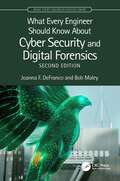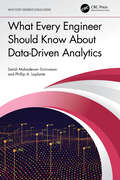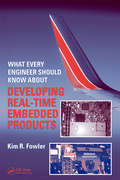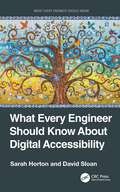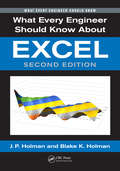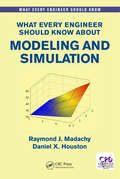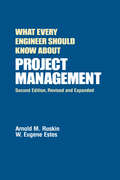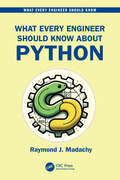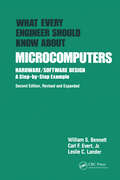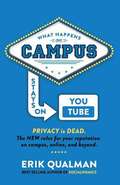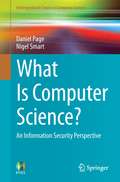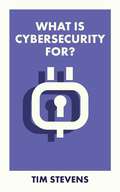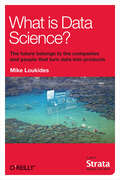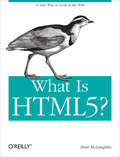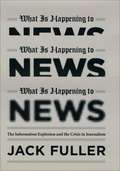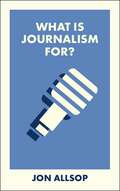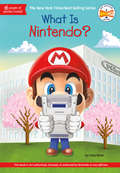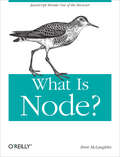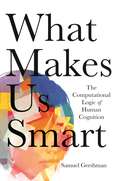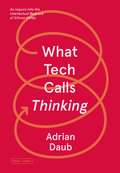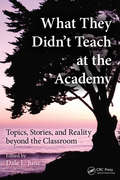- Table View
- List View
What Every Engineer Should Know About Cyber Security and Digital Forensics (What Every Engineer Should Know)
by Joanna F. DeFranco Bob MaleyMost organizations place a high priority on keeping data secure, but not every organization invests in training its engineers or employees in understanding the security risks involved when using or developing technology. Designed for the non-security professional, What Every Engineer Should Know About Cyber Security and Digital Forensics is an overview of the field of cyber security. The Second Edition updates content to address the most recent cyber security concerns and introduces new topics such as business changes and outsourcing. It includes new cyber security risks such as Internet of Things and Distributed Networks (i.e., blockchain) and adds new sections on strategy based on the OODA (observe-orient-decide-act) loop in the cycle. It also includes an entire chapter on tools used by the professionals in the field. Exploring the cyber security topics that every engineer should understand, the book discusses network and personal data security, cloud and mobile computing, preparing for an incident and incident response, evidence handling, internet usage, law and compliance, and security forensic certifications. Application of the concepts is demonstrated through short case studies of real-world incidents chronologically delineating related events. The book also discusses certifications and reference manuals in the areas of cyber security and digital forensics. By mastering the principles in this volume, engineering professionals will not only better understand how to mitigate the risk of security incidents and keep their data secure, but also understand how to break into this expanding profession.
What Every Engineer Should Know About Data-Driven Analytics (What Every Engineer Should Know)
by Phillip A. Laplante Satish Mahadevan SrinivasanWhat Every Engineer Should Know About Data-Driven Analytics provides a comprehensive introduction to the theoretical concepts and approaches of machine learning that are used in predictive data analytics. By introducing the theory and by providing practical applications, this text can be understood by every engineering discipline. It offers a detailed and focused treatment of the important machine learning approaches and concepts that can be exploited to build models to enable decision making in different domains. Utilizes practical examples from different disciplines and sectors within engineering and other related technical areas to demonstrate how to go from data, to insight, and to decision making. Introduces various approaches to build models that exploits different algorithms. Discusses predictive models that can be built through machine learning and used to mine patterns from large datasets. Explores the augmentation of technical and mathematical materials with explanatory worked examples. Includes a glossary, self-assessments, and worked-out practice exercises. Written to be accessible to non-experts in the subject, this comprehensive introductory text is suitable for students, professionals, and researchers in engineering and data science.
What Every Engineer Should Know About Developing Real-Time Embedded Products (What Every Engineer Should Know)
by Kim R. FowlerYou can find them in your wristwatch or MP3 player; they perform specific functions in washing machines, traffic lights, and even pacemakers. Embedded systems are pervasive, ubiquitous, and widespread throughout our daily lives. Developing these real-time embedded products requires an understanding of the interactions between different disciplines,
What Every Engineer Should Know About Digital Accessibility (ISSN)
by Sarah Horton David SloanAccessibility is a core quality of digital products to be deliberately addressed throughout the development lifecycle. What Every Engineer Should Know About Digital Accessibility will prepare readers to integrate digital accessibility into their engineering practices. Readers will learn how to accurately frame accessibility as an engineering challenge so they are able to address the correct problems in the correct way.Illustrated with diverse perspectives from accessibility practitioners and advocates, this book describes how people with disabilities use technology, the nature of accessibility barriers in the digital world, and the role of engineers in breaking down those barriers. Accessibility competence for current, emerging, and future technologies is addressed through a combination of guiding principles, core attributes and requirements, and accessibility‑informed engineering practices.FEATURES Discusses how technology can support inclusion for people with disabilities and how rigorous engineering processes help create quality user experiences without introducing accessibility barriers Explains foundational principles and guidelines that build core competency in digital accessibility as they are applied across diverse and emerging technology platforms Highlights practical insights into how engineering teams can effectively address accessibility throughout the technology development lifecycle Uses international standards to define and measure accessibility quality Written to be accessible to non‑experts in the subject area, What Every Engineer Should Know About Digital Accessibility is aimed at students, professionals, and researchers in the field of software engineering.
What Every Engineer Should Know About Excel (What Every Engineer Should Know #50)
by J. P. Holman Blake K. Holman<p>Understanding the powerful computational and graphics capabilities of Microsoft Excel is an enormous benefit to engineers and technical professionals in almost any field and at all levels of experience. What Every Engineer Should Know About Excel is a practical guide to unlocking the features and functions of this program, using examples and screenshots to walk readers through the steps to build a strong understanding of the material. <p>This second edition is updated to reflect the latest version of Excel (2016) and expands its scope to include data management, connectivity to external data sources, and integration with "the cloud" for optimal use of the Excel product. It also introduces the ribbon bar navigation prevalent in Microsoft products beginning with the 2007 version of MS Office. Covering a variety of topics in self-contained chapters, this handy guide will also prove useful for professionals in IT, finance, and real estate.</p>
What Every Engineer Should Know About Modeling and Simulation (What Every Engineer Should Know)
by Raymond J. Madachy Daniel HoustonThis practical book presents fundamental concepts and issues in computer modeling and simulation (M&S) in a simple and practical way for engineers, scientists, and managers who wish to apply simulation successfully to their real-world problems. It offers a concise approach to the coverage of generic (tool-independent) M&S concepts and enables engineering practitioners to easily learn, evaluate, and apply various available simulation concepts. Worked out examples are included to illustrate the concepts and an example modeling application is continued throughout the chapters to demonstrate the techniques. The book discusses modeling purposes, scoping a model, levels of modeling abstraction, the benefits and cost of including randomness, types of simulation, and statistical techniques. It also includes a chapter on modeling and simulation projects and how to conduct them for customer and engineer benefit and covers the stages of a modeling and simulation study, including process and system investigation, data collection, modeling scoping and production, model verification and validation, experimentation, and analysis of results.
What Every Engineer Should Know About Project Management
by Arnold M. Ruskin W. Eugene EstesCovering the roles and responsibilities of the project manager, this second edition describes requirement specifications, work breakdown structures, project control and risk management, and offers new information on motivation, matrix arrangements, and project records. Discussing the anatomy of a project planning and control and techniques, the aut
What Every Engineer Should Know About Python (What Every Engineer Should Know)
by Raymond J. MadachyEngineers across all disciplines can benefit from learning Python. This powerful programming language enables engineers to enhance their skill sets and perform more sophisticated work in less time, whether in engineering analysis, system design and development, integration and testing, machine learning and other artificial intelligence applications, project management, or other areas. What Every Engineer Should Know About Python offers students and practicing engineers a straightforward and practical introduction to Python for technical programming and broader uses to enhance productivity. It focuses on the core features of Python most relevant to engineering tasks, avoids computer science jargon, and emphasizes writing useful software while effectively leveraging generative AI. Features examples tied to real-world engineering scenarios that are easily adapted Explains how to leverage the vast ecosystem of open-source Python packages for scientific applications, rather than developing new software from scratch Covers the incorporation of Python into engineering designs and systems, whether web-based, desktop, or embedded Provides guidance on optimizing generative AI with Python, including case study examples Describes software tool environments and development practices for the rapid creation of high-quality software Demonstrates how Python can improve personal and organizational productivity through workflow automation Directs readers to further resources for exploring advanced Python features This practical and concise book serves as a self-contained introduction for engineers and readers from scientific disciplines who are new to programming or to Python.
What Every Engineer Should Know About the Internet of Things (What Every Engineer Should Know)
by Joanna F. DeFranco Mohamad KassabInternet of Things (IoT) products and cyber-physical systems (CPS) are being utilized in almost every discipline and there continues to be significant increases in spending on design, development, and deployment of IoT applications and analytics within every domain, from our homes, schools, government, and industry. This practical text provides an introduction to IoT that can be understood by every engineering discipline and discusses detailed applications of IoT. Developed to help engineers navigate this increasingly important and cross-disciplinary topic, this work: Offers research-based examples and case studies to facilitate the understanding of each IoT primitive Highlights IoT’s connection to blockchain Provides and understanding of benefits and challenges of IoT and its importance to a variety of engineering disciplines Written to be accessible to non-experts in the subject, What Every Engineer Should Know About the Internet of Things communicates the importance of this technology and how it can support and challenge all interrelated actors as well as all involved assets across many domains.
What Every Engineer Should Know about Microcomputers: Hardware/Software Design: a Step-by-step Example, Second Edition,
by William S. Bennett Carl F. Evert Jr. Leslie C. LanderRevised and expanded guide demonstrates microcomputer usage by working through one simple design challenge and explaining its solution. This edition features the contributions of an Ada expert, demonstrates (in 14 new chapters) the development of a microcomputer system structured by this language.
What Every Engineer Should Know about Software Engineering (What Every Engineer Should Know)
by Phillip A. Laplante Mohamad KassabThis book offers a practical approach to understanding, designing, and building sound software based on solid principles. Using a unique Q&A format, this book addresses the issues that engineers need to understand in order to successfully work with software engineers, develop specifications for quality software, and learn the basics of the most common programming languages, development approaches, and paradigms. The new edition is thoroughly updated to improve the pedagogical flow and emphasize new software engineering processes, practices, and tools that have emerged in every software engineering area. Features: Defines concepts and processes of software and software development, such as agile processes, requirements engineering, and software architecture, design, and construction. Uncovers and answers various misconceptions about the software development process and presents an up-to-date reflection on the state of practice in the industry. Details how non-software engineers can better communicate their needs to software engineers and more effectively participate in design and testing to ultimately lower software development and maintenance costs. Helps answer the question: How can I better leverage embedded software in my design? Adds new chapters and sections on software architecture, software engineering and systems, and software engineering and disruptive technologies, as well as information on cybersecurity. Features new appendices that describe a sample automation system, covering software requirements, architecture, and design. This book is aimed at a wide range of engineers across many disciplines who work with software.
What Every Teacher Should Know About Media and Technology
by Donna E. TilestonTechnology plus classroom can equal success for students. This invaluable resource for teachers presents classroom applications of media, technology, and the Internet.
What Happens on Campus Stays on YouTube: Privacy Is Dead. The New Rules For Your Reputation On Campus, Online And Beyond
by Erik QualmanWhether we like it, love it, use it or hate it, escaping social media on any college campus is nearly impossible. When you arrive on campus, you will notice that social media isn't just a way to connect with friends but also a vast communication and marketing network for student organizations, internship opportunities and more! The purpose of this book is to not to tell you to avoid social media, but to help you start thinking about your digital reputation and providing you with some expert advice on using social media in a smart way. Even if you don't want to dive in right now, keep this book on your shelf for your future reference.
What Is Computer Science?
by Daniel Page Nigel SmartThis engaging and accessible text addresses the fundamental question: What Is Computer Science? The book showcases a set of representative concepts broadly connected by the theme of information security, for which the presentation of each topic can be treated as a "mini" lecture course, demonstrating how it allows us to solve real problems, as well as how it relates to other subjects. The discussions are further supported by numerous examples and practical hands-on exercises. Features: presents a concise introduction to the study of algorithms and describes how computers work; introduces the concepts of data compression, and error detection and correction; highlights the role of data structures; explores the topic of web-search; reviews both historic and modern cryptographic schemes, examines how a physical system can leak information and discusses the idea of randomness; investigates the science of steganography; provides additional supplementary material at an associated website.
What Is Cybersecurity For? (What Is It For?)
by Tim StevensHow will protecting our digital infrastructure shape our future? Cybersecurity is one of the key practical and political challenges of our time. It is at the heart of how modern societies survive and thrive, yet public understanding is still rudimentary: media portrayals of hoodie-wearing hackers accessing the Pentagon don’t convey its complexity or significance to contemporary life. This book addresses this gap, showing that the political dimension is as important as the technological one. It accessibly explains the complexities of global information systems, the challenges of providing security to users, societies, states and the international system, and the multitude of competing players and ambitions in this arena. Making the case for understanding it not only as a technical project, but as a crucial political one that links competing visions of what cybersecurity is for, it tackles the ultimate question: how can we do it better?
What Is Data Science?
by Mike LoukidesWe've all heard it: according to Hal Varian, statistics is the next sexy job. Five years ago, in What is Web 2.0, Tim O'Reilly said that "data is the next Intel Inside." But what does that statement mean? Why do we suddenly care about statistics and about data? This report examines the many sides of data science -- the technologies, the companies and the unique skill sets.The web is full of "data-driven apps." Almost any e-commerce application is a data-driven application. There's a database behind a web front end, and middleware that talks to a number of other databases and data services (credit card processing companies, banks, and so on). But merely using data isn't really what we mean by "data science." A data application acquires its value from the data itself, and creates more data as a result. It's not just an application with data; it's a data product. Data science enables the creation of data products.
What Is HTML5?
by Brett McLaughlinHTML5: Everyone’s using it, nobody knows what it is. I realize that sounds more like a line out of an existential movie — maybe Waiting for Godot or a screenplay by Sartre — than a statement about HTML5. But it’s really the truth: most of the people using HTML5 are treating it as HTML4+, or even worse, HTML4 (and some stuff they don’t use). The result? A real delay in the paradigm shift that HTML5 is almost certain to bring. It’s certainly not time to look away, because by the time you look back, you may have missed something really important: a subtle but important transition centered around HTML5.
What Is Happening to News: The Information Explosion and the Crisis in Journalism
by Jack Fuller<P>Across America, newspapers that have defined their cities for over a century are rapidly failing, their circulations plummeting even as opinion-soaked Web outlets like the Huffington Post thrive. Meanwhile, nightly news programs shock viewers with stories of horrific crime and celebrity scandal, while the smug sarcasm and shouting of pundits like Glenn Beck and Keith Olbermann dominate cable television. <P> Is it any wonder that young people are turning away from the news entirely, trusting comedians like Jon Stewart as their primary source of information on current events? In the face of all the problems plaguing serious news, What Is Happening to News explores the crucial question of how journalism lost its way--and who is responsible for the ragged retreat from its great traditions. <P>Veteran editor and newspaperman Jack Fuller locates the surprising sources of change where no one has thought to look before: in the collision between a revolutionary new information age and a human brain that is still wired for the threats faced by our prehistoric ancestors. <P>Drawing on the dramatic recent discoveries of neuroscience, Fuller explains why the information overload of contemporary life makes us dramatically more receptive to sensational news, while rendering the staid, objective voice of standard journalism ineffective. <P>Throw in a growing distrust of experts and authority, ably capitalized on by blogs and other interactive media, and the result is a toxic mix that threatens to prove fatal to journalism as we know it. <P>For every reader troubled by what has become of news--and worried about what the future may hold--What Is Happening to News not only offers unprecedented insight into the causes of change but also clear guidance, strongly rooted in the precepts of ethical journalism, on how journalists can adapt to this new environment while still providing the information necessary to a functioning democracy.
What Is Journalism For? (What Is It For?)
by Jon AllsopWhat is at stake when journalism is threatened? Does society still need journalists? Journalism faces multiple threats today all over the world: economic decline, online disinformation, the rise of AI, authoritarian curbs on freedom of the press, and violence against journalists. In such a climate, it’s more urgent than ever to ask what journalism is for. Drawing on his experience as a journalist and media commentator, and on interviews with journalists from the US to Myanmar, Jon Allsop examines key concepts that constitute journalism’s role: good judgement, concern for truth and critical scrutiny of one or more communities. Along the way, he also considers the relationship between journalism and activism; whether journalists should aspire to change the world and whether they can be seen as champions of democracy.
What Is Nintendo? (What Was?)
by Gina Shaw Who HQThe game is on! Get your hands on this book about one of the most influential companies in the video game industry.Founded in 1889, Nintendo started out as a small playing card company in Japan. Though the cards sold well, Nintendo really became popular when it began creating toys in the 1960s, and then became internationally renowned after developing video games and consoles in the 1970s and '80s. After introducing the world to some of the best-known and top-selling video game franchises of all-time, such as Super Mario Bros., The Legend of Zelda, Animal Crossing, and Pokémon, it's clear to see why Nintendo is beloved by parents as a company that creates nonviolet, family-friendly entertainment for kids.With fun black-and-white illustrations and an engaging 16-page photo insert, readers will be excited to read this latest additon to Who HQ!
What Is Node?
by Brett McLaughlinNode.js. It’s the latest in a long line of “Are you cool enough to use me?” programming languages, APIs, and toolkits. In that sense, it lands squarely in the tradition of Rails, and Ajax, and Hadoop, and even to some degree iPhone programming and HTML5.Dig a little deeper, and you’ll hear that Node.js (or, as it’s more briefly called by many, simply “Node”) is a server-side solution for JavaScript, and in particular, for receiving and responding to HTTP requests. If that doesn’t completely boggle your mind, by the time the conversation heats up with discussion of ports, sockets, and threads, you’ll tend to glaze over. Is this really JavaScript? In fact, why in the world would anyone want to run JavaScript outside of a browser, let alone the server?The good news is that you’re hearing (and thinking) about the right things. Node really is concerned with network programming and server-side request/response processing. The bad news is that like Rails, Ajax, and Hadoop before it, there’s precious little clear information available. There will be, in time — as there now is for these other “cool” frameworks that have matured — but why wait for a book or tutorial when you might be able to use Node today, and dramatically improve the maintainability.
What Makes Us Smart: The Computational Logic of Human Cognition
by Samuel GershmanHow a computational framework can account for the successes and failures of human cognitionAt the heart of human intelligence rests a fundamental puzzle: How are we incredibly smart and stupid at the same time? No existing machine can match the power and flexibility of human perception, language, and reasoning. Yet, we routinely commit errors that reveal the failures of our thought processes. What Makes Us Smart makes sense of this paradox by arguing that our cognitive errors are not haphazard. Rather, they are the inevitable consequences of a brain optimized for efficient inference and decision making within the constraints of time, energy, and memory—in other words, data and resource limitations. Framing human intelligence in terms of these constraints, Samuel Gershman shows how a deeper computational logic underpins the “stupid” errors of human cognition.Embarking on a journey across psychology, neuroscience, computer science, linguistics, and economics, Gershman presents unifying principles that govern human intelligence. First, inductive bias: any system that makes inferences based on limited data must constrain its hypotheses in some way before observing data. Second, approximation bias: any system that makes inferences and decisions with limited resources must make approximations. Applying these principles to a range of computational errors made by humans, Gershman demonstrates that intelligent systems designed to meet these constraints yield characteristically human errors.Examining how humans make intelligent and maladaptive decisions, What Makes Us Smart delves into the successes and failures of cognition.
What Tech Calls Thinking: An Inquiry into the Intellectual Bedrock of Silicon Valley (FSG Originals x Logic)
by Adrian Daub"In Daub’s hands the founding concepts of Silicon Valley don’t make money; they fall apart." --The New York Times Book Review From FSGO x Logic: a Stanford professor's spirited dismantling of Silicon Valley's intellectual originsAdrian Daub’s What Tech Calls Thinking is a lively dismantling of the ideas that form the intellectual bedrock of Silicon Valley. Equally important to Silicon Valley’s world-altering innovation are the language and ideas it uses to explain and justify itself. And often, those fancy new ideas are simply old motifs playing dress-up in a hoodie. From the myth of dropping out to the war cry of “disruption,” Daub locates the Valley’s supposedly original, radical thinking in the ideas of Heidegger and Ayn Rand, the New Age Esalen Foundation in Big Sur, and American traditions from the tent revival to predestination. Written with verve and imagination, What Tech Calls Thinking is an intellectual refutation of Silicon Valley's ethos, pulling back the curtain on the self-aggrandizing myths the Valley tells about itself.FSG Originals × Logic dissects the way technology functions in everyday lives. The titans of Silicon Valley, for all their utopian imaginings, never really had our best interests at heart: recent threats to democracy, truth, privacy, and safety, as a result of tech’s reckless pursuit of progress, have shown as much. We present an alternate story, one that delights in capturing technology in all its contradictions and innovation, across borders and socioeconomic divisions, from history through the future, beyond platitudes and PR hype, and past doom and gloom. Our collaboration features four brief but provocative forays into the tech industry’s many worlds, and aspires to incite fresh conversations about technology focused on nuanced and accessible explorations of the emerging tools that reorganize and redefine life today.
What They Didn't Teach at the Academy: Topics, Stories, and Reality beyond the Classroom
by Dale L. JuneWhile professional courses and how-to manuals can prepare us for expected events that will occur in the course of our careers, there remains an untapped reservoir of life experience that cannot be prepared for in training or study. Revised to include more information on analytical models for wavelength independence, Radiation Heat Transfer, Augmented Edition has been rearranged, providing problems within each chapter rather than at the end of the book. Written by Ephraim M. Sparrow, a generalist who works on a very broad range of problems that encompasses almost all mechanical engineering topics, the book presents key ideas without being exhaustive. Sparrow is in charge of the Laboratory for Heat Transfer and Fluid Flow Practice, whose function in to undertake both industrially bases and fundamental problems that fall within the bounds of heat transfer and fluid flow.
What To Do When You Get Hacked: A Practitioner's Guide to Incident Response in the 21st Century
by Shimon BrathwaiteWhat To Do When You Get Hacked: A Practitioner’s Guide to Incident Response in the 21st Century teaches you everything that you need to know about preparing your company for a potential data breach. We begin by talking about what the latest cybersecurity threats and attacks are that your company needs to be prepared for. Once we establish that, we go into the different phases of the incident response lifecycle based on the NIST framework. This will teach you how to properly prepare and respond to cybersecurity incidents so that you can be sure to minimize damage and fulfill all of your legal requirements during a cyberattack. This book is meant for the everyday business owner and makes these concepts simple to understand and apply.
